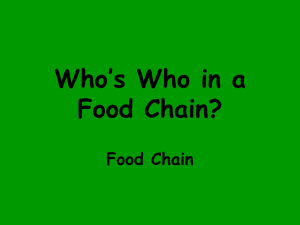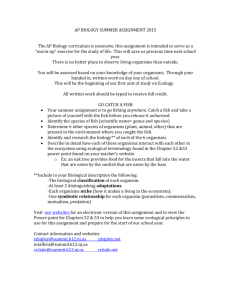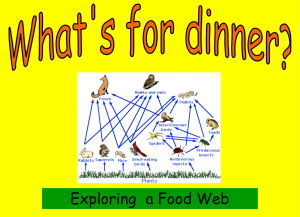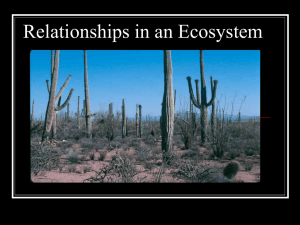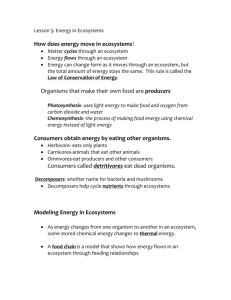Yellowstone Food Web
advertisement
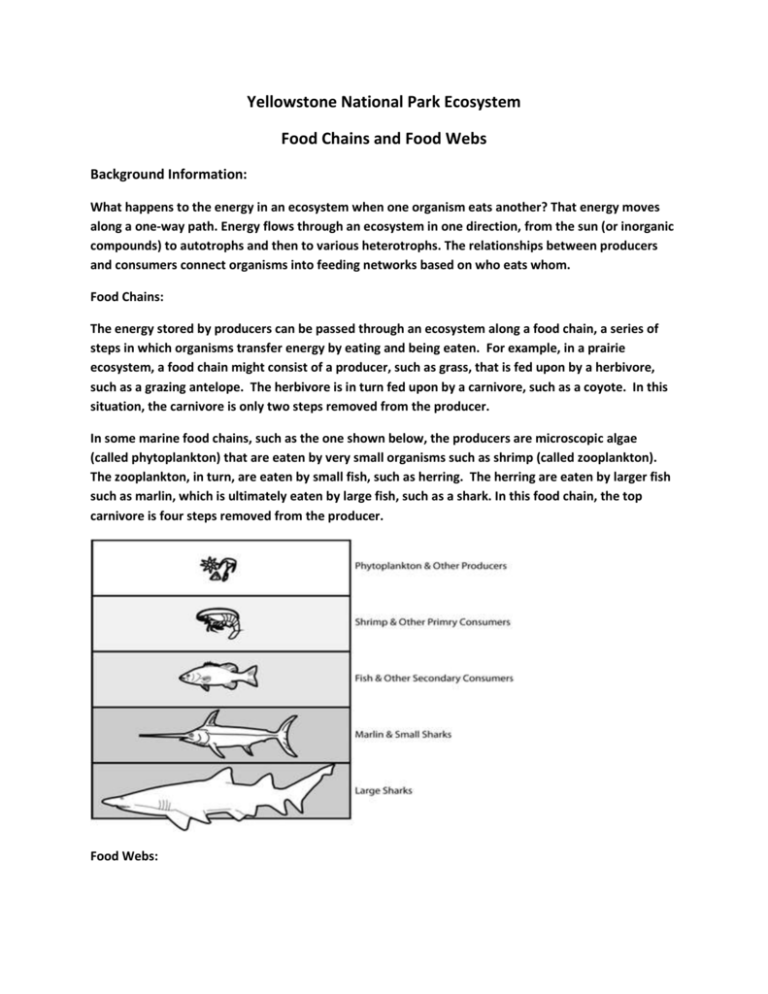
Yellowstone National Park Ecosystem Food Chains and Food Webs Background Information: What happens to the energy in an ecosystem when one organism eats another? That energy moves along a one-way path. Energy flows through an ecosystem in one direction, from the sun (or inorganic compounds) to autotrophs and then to various heterotrophs. The relationships between producers and consumers connect organisms into feeding networks based on who eats whom. Food Chains: The energy stored by producers can be passed through an ecosystem along a food chain, a series of steps in which organisms transfer energy by eating and being eaten. For example, in a prairie ecosystem, a food chain might consist of a producer, such as grass, that is fed upon by a herbivore, such as a grazing antelope. The herbivore is in turn fed upon by a carnivore, such as a coyote. In this situation, the carnivore is only two steps removed from the producer. In some marine food chains, such as the one shown below, the producers are microscopic algae (called phytoplankton) that are eaten by very small organisms such as shrimp (called zooplankton). The zooplankton, in turn, are eaten by small fish, such as herring. The herring are eaten by larger fish such as marlin, which is ultimately eaten by large fish, such as a shark. In this food chain, the top carnivore is four steps removed from the producer. Food Webs: In most ecosystems, feeding relationships are more complex than can be shown in a food chain. Consider, for example, the relationships in a salt marsh. Although some producers—including marsh grass and other salt-tolerant plants—are eaten directly by water birds, grasshoppers, and other herbivores, most producers complete their life cycles, then die and decompose. Decomposers convert the dead plant matter to detritus, which is eaten by detritivores, such as zooplankton. The detritivores are in turn eaten by organisms such as insects and small fish and so on. Add frogs, birds, larger fish and hawks to the scenario, and feeding relationships can get very confusing! When the feeding relationships among the various organisms in an ecosystem form a network of complex interactions, ecologists describe these relationships as a food web. A food web links all the food chains in an ecosystem together. The food web below shows the feeding relationships in a saltmarsh community. Yellowstone National Park Ecosystem Food Chains and Food Webs Producers Herbivores Omnivores Carnivores *TC=Top Carnivores Aspen trees Elk Raven Grey Wolf* (TC) Cottonwood trees Bison Magpie Coyote Pine Trees Deer Hapless Merganser Black Bear* (TC) Spruce Trees Voles Canadian Geese Grizzly Bear* (TC) Fir Trees Beavers Loons Bald Eagle* (TC) Juniper Trees Algae-eating Fish Mountain Bluebirds American White Pelican Wildflowers Insects Fish Frogs Perennials/Shrubs Mouse Sandhill Crane Large Fish Grasses Squirrels Cedar Waxwing Lizards Algae Caddis Flies Fish Red Fox Shrubs Rabbits Willows River Otter Scavengers: Vultures Instructions: 1. Use the list of organisms above, on a blank white piece of paper, build a diagram showing the position of all of them in a food web of the Yellowstone Ecosystem. Ideally, the producers are at the bottom of the food web and the top carnivores are at the top. Show the scavengers in a separate location on the food web. (30 points) HINT: Do your food web in pencil! 2. Next, show the energy flow by indicating who eats who with an arrow. For example, to show that deer eat grass, show it like this: (15 points) Grass → Deer 3. Finally, on the back of the food web, draw 3 different food chains. Make sure each food chain starts with a producer and ends with a top carnivore. Label each of the organisms in the food chain with one of the following labels: Producer, Primary Consumer, Secondary Consumer, Tertiary Consumer, Quaternary Consumer, Top Carnivore. (15 points). Yellowstone National Park Ecosystem Reintroduction of the Wolves Timeline of Events Instructions: 1. Read the article “Reintroduction of the Wolves”. Then, using information from the article, draw a timeline of events with information under each event. An example follows below: Event: Event: → ____________________ ____________________ ____________________ ____________________ ____________________ ____________________ ____________________ ____________________ Your timeline will start with the eradication of the wolves from Yellowstone in the 1920s. Under each event, write a sentence or two about the effects of that event. Make sure your timeline describes the changes and their effects on the following species: Eradication of Wolves Return of Wolves Aspen Trees Cottonwood Trees Elk Populations Beaver Populations NOTE: I’m not going to give you an exact number of events you need to include, because it may vary depending on how well you explain the effects of each event. I will tell you that you need to have a minimum of 5 events, but you could have several more. Just make sure you explain each event and its’ effects completely.
